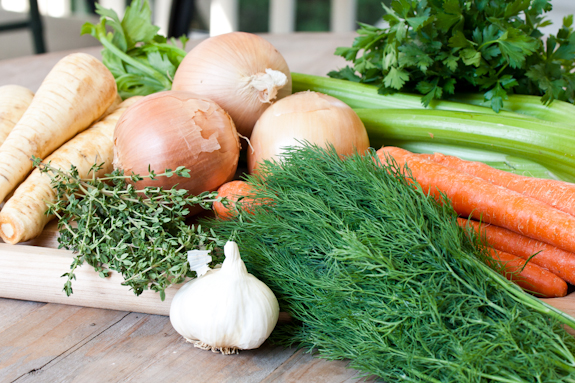How to Make Homemade Chicken Stock

I thought we might just kind of slip right past Winter this year, considering it was warm enough (in the 70’s!) to sit outside and have Thanksgiving dinner just a week ago. However, Winter is definitely now on its way with temperatures in the 20’s at night.
At the Bunkycooks, now would be the time to pull out those fuzzy pajamas and crank up a roaring fire start making some of my favorite dishes for these freakin’ cold nights this time of year. These include homemade soups, stews and braised dishes. The key, to me, to a rich and satisfying dish that will totally knock your socks off in the flavor department is homemade chicken stock!
I am talking about the kinds of dishes that you serve with a lovely green salad, a crusty loaf of French bread and a great bottle of wine. This will be all you will want or need for an evening’s dinner on a frosty night. Well, maybe a roaring fire, a warm body (Mr. B) and a big binkie wouldn’t be so bad either! 😉 Can I add a cute and shaggy dog to that list?!
Yes, you can certainly substitute store bought chicken broth in recipes (and I do it for certain things or if I am out of my homemade stock), but until you try your own stock in dishes, you will never know just how good truly amazing they can really be! This is one of the secrets in any good cook’s kitchen and in restaurants. One way they create complex flavors is by adding homemade stocks.
It takes a bit of time to make your own stock, but for the most part, you just let the stock cook away on the stove. You can go about your business (like baking cookies or playing on the internet) and come back hours later (with a bit of checking in between) to rich and luscious homemade chicken stock! Wait until you smell the house while it simmers away…it’s like chicken soup on steroids!
The difference in this and the store bought variety is that it is gelatinous, dark and flavorful because you have simmered fresh aromatics and whole chickens together for hours. You can also adjust your seasonings, especially the salt, which is very important to me. (That is why I always use low-sodium chicken broth when I do buy it). You can always add salt, but you cannot take it away.
You will need a 20 quart stock pot to hold all of these ingredients. This will allow for just a bit of space at the top of the pot.
Save this really good stuff for more complicated dishes where depth of flavor matters, like French Pumpkin Soup, Braised Lamb Shanks or Risotto. You will never go back to the boxed stuff again!
As much as you might want to try to salvage the cooked chicken from this recipe, do not do it. It is not edible. All the goodness is now in the stock. What is left of the chicken is not fit for man nor beast my dog.
Strain the stock into another pot once it has cooked for 4 hours and then chill overnight. Remove the fat from the top of the stock. The stock will be very thick and gelatinous. I like to warm it up to redistribute the seasonings and then ladle into freezer-safe containers.
Be sure to use it in a day or two or keep it in the freezer for up up to 3 months (preferably). It will keep up to 6 months, but you will want to make oodles and oodles of delectable dishes with this, so my bet is it won’t last that long!

Homemade Chicken Stock
Adapted from Barefoot Contessa Family Style, Ina Garten
Makes 8 quarts
Ingredients:
3 (5-pound) chickens, preferably organic
3 large yellow onions, unpeeled and quartered
6 carrots, unpeeled and halved
4 stalks celery with leaves, cut into thirds
4 parsnips, unpeeled and cut in half, optional (I always use them. I think they add great flavor.)
20 sprigs fresh parsley
15 sprigs fresh thyme
20 sprigs fresh dill
1 head garlic, unpeeled and cut in 1/2 crosswise
2 tablespoons Kosher salt
2 teaspoons whole black peppercorns
Directions:
Place the chickens, onions, carrots, celery, parsnips, parsley, thyme, dill, garlic, and seasonings in a 16 to 20-quart stockpot (I use a 20-quart stockpot). Add 7 quarts of water and bring to a boil.
Simmer, uncovered, for 4 hours. Strain the entire contents of the pot through a colander and discard the solids into a clean pot. Chill the stock overnight.
The next day, remove the surface fat. * I suggest warming the stock to redistribute the seasonings before ladling the mixture into containers.
Use immediately or pack in freezer-safe containers and freeze for up to 6 months (although 3 months is preferable). I also place them in freezer bags so they are airtight.





















Homemade stock is so so good and makes all the difference in lots of dishes. Great post!
I’ve been making chicken stock for the last 7 months and boy-oh-boy does it make a difference in ALL MY FOOD! I roast a chicken almost weekly to get my stock. Last week, I roasted the turkey carcass! Having stock in my freezer makes me HAPPY!
This blog is the highlight of my inbox every time! I always wondered what the difference is between all the store stocks and broths.
I just love the fact that you don’t have to peel the onion for this recipe. I recall seeing people cook stock with all peeled and neat looking ingredients. And cooked chicken carcasses rather than raw chicken. This is just so much more my style.
I cannot wait to get started.
You totally inspired me. I printed out the recipe to make tomorrow, and in the meantime, made a small pot of vegetable broth for me for tonight. My family is going to LOVE next week’s risotto, among other things.
I agree with you about the parsnips.
I love it when people make homemade stock!!! I have a confession to make – We have our dog on a RAW food diet… In a nutshell, what that means is every other day, Mr. RGBistro breaks down a chicken for Britta the weimaraner to eat. Dog gets the legs, wings and breasts… we save the necks and backs. And every time we hit 8 sets of necks and backs (every two weeks or so), we make a stock. About half is always used right away; the other half gets frozen into silicone muffin tins and are saved in the freezer. To go one step further, when we skim off the chicken fat, we save a half a cup of it to throw into our flaxseed dog biscuit recipe. Chickens get a lot of mileage at the RGB. 🙂
[K]
I must agree that homemade chicken stock can make a HUGE difference in soups. I love using stock that my mom makes, and now I’m going to have to try making my own. Thank you so much for sharing! Have a good Sunday afternoon.
This is a wonderful post and I couldn’t agree more with you about the deliciousness of homemade chicken stock. Have a nice Sunday and hope you’re on the mend:)
you just can’t beat homemade stock – i make it every couple of months using Ruhlman’s roasting method – perfect every time! And Kim over at RGBistro – you are a total RAWK STAR!
I have a rule — my kitchen should always have the following — Saltine Crackers, Ginger Ale, Jell-O and home made Chicken Stock. That’s the secret to warding off evil germs. The problem is I go through my stock very quickly, so I seem to always be making more. It’s probably the thing I’ve written most about on my blog and I’ve got a Hanukkah post in the draft file waiting to be finished with one of the headline dishes being Matzo Ball Soup.
The skimmed off fat makes for perfect matzo balls.
I’m making a pot of stock today…for chicken and rice soup tonight. After I finally figured out how to make homemade stock it right, it’s made all the difference in the world to my soups.
Can’t wait to make this tomorrow. I read somewhere (a Mark Bittman cookbook, I think) that, if the stock has been in the fridge for 3-4 days, boil it again to keep it longer.
Hi Marie,
Yes, I would try to get it cooled, strained, fat removed and then in the freezer within 2 days, if possible. You can bring it to a boil after you remove the fat layer and redistribute the flavors throughout the stock before dividing it up into containers.
I would definitely use it within a few days or put it in the freezer for longer storage. If it’s properly sealed (I double wrap mine), it can last up to six months and maybe a little longer.
Gwen